On 11 September 2024, we gathered policymakers, industry leaders, and the Hogan Lovells team to attend our annual summit on digital assets and tokenization, held in partnership with Global Digital Finance.
The Key Takeaways
- This past year has shown that institutional adoption is steadily increasing, and we are now seeing innovations in the wholesale space as well as in retail services;
- The positive attitude being taken by central banks to experiment with tokenization and other new technologies is encouraging;
- Interoperability is needed to fully reap the benefits of tokenization and programmable platforms;
- The transition from legacy systems to those based on new platforms may require a “parallel tracks” approach in the immediate term, where old and new infrastructures co-exist;
- The future of digital money and payments is likely to include a mix of different instruments, from digital forms of private money such as stablecoins and tokenized deposits to central bank digital currencies;
- Global standards are welcome, although (i) industry recognizes the practical challenges of developing and implementing global standards, and (ii) policy decisions (such as whether or not to issue a central bank digital currency) needs to be tailored to circumstances of the relevant jurisdictions;
- Those that sit outside of traditional finance and institutional systems may face fewer constraints to innovation. At the same there is an obvious and justifiable need for regulators to preserve financial stability and integrity of the markets. The questions remain in terms of how regulation can strike the right balance, how the role of intermediaries will evolve, as well as how traditional finance and decentralized finance may interact in future.
Opening keynote: Francesca Hopwood Road
We were honored to be joined by Francesca Hopwood Road, Head of the BIS Innovation Hub’s London Centre, to deliver the opening keynote speech.
Road reflected on the growth of the digital assets space. Regardless of one’s attitude towards crypto-assets, it is undeniable that the developments in the crypto market demonstrates, and provides valuable insight into, what is achievable via innovation in novel technologies in terms of efficiency gains and accessibility.
The “traditional” space of regulated financial services is markedly different, and for good reason—for example, regulation facilitates certainty in ownership of assets, settlement finality, investor protection, and resilient market infrastructures. Still, central banks around the world aspire to improve the functioning of the financial system for the public good. Innovation can present both risks and opportunities, and although it is important for central bank money to retain its role as a settlement asset—as an “anchor” in the financial system—central bank money must keep pace with technological advancements in the private sector.
The BIS Innovation Hub has been at the forefront of research and experimentation in the FinTech space, in collaboration with both public and private sectors. The issues being explored in current projects, whether in the form of proof of concepts or prototypes, range from interoperability between real-time gross settlement systems and distributed ledger technologies in the context of foreign exchange transactions (Project Meridian FX), to integration of tokenized commercial bank deposits with tokenized wholesale central bank money in a public-private programmable platform, in line with the concept of the “unified ledger” (Project Agora). Other topics being explored include tokenized promissory notes (Project Promissa) and how artificial intelligence may be used to combat financial crime (Project Aurora).
In closing, Road advocated for further collaboration between private and public sectors, whereby the public sector can learn about the opportunities offered by novel technologies and new use cases that central banks can engage with, and the private sector can further their understanding of how to navigate the risks facing the financial systems today.
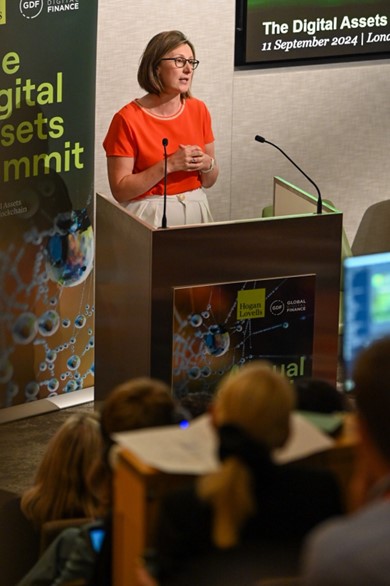
Francesca Hopwood Road, the Bank of International Settlements Innovation Hub
A Tokenized Financial Ecosystem: The Signals of Institutional Adoption
Panel discussion
Hogan Lovells Partner Bryony Widdup led the panel discussion on the signals of institutional adoption of tokenization in the financial services ecosystem. The panel included Lauren Pau, Senior Managing Counsel at BNY; John Thiede, Associate General Counsel at HSBC; Peter Left, Head of Digital and Markets Innovation at Lloyds; Max Boonen, Founder of PV01; and Sonia Chawla, Head of Legal, Investment Transactions at Schroders.
The panelists represented a range of different perspectives: Thiede spoke of HSBC’s digital strategy and, in particular, developments in native digital bond issuances on the Orion platform as well as tokenization of gold; Pau noted BNY’s aspirations to expand its digital asset custody offering to institutional clients; Chawla reflected on Schroder’s experience, particularly as an initial buyer of the digital bond issued by the EIB; Left discussed Lloyd’s focus on digital money and the importance of having a currency medium which can support digital asset workflows; and in contrast, Boonen, as founder of PV01 which allows for the direct purchase of US treasury bills via stablecoins, commented on the usefulness of distributed ledger technology in improving market access and potentially allowing for the complete disintermediation of the financial services ecosystem.
Industry focus on “interoperability” was highlighted by the panelists as a key signal of institutional adoption. The panel noted the shift in discussions within the market towards focusing on enabling liquidity and interconnectivity between different DLT-based platforms as well as traditional financial market infrastructures and, in the future, there may be conversations around the potential convergence of traditional finance and decentralized finance. Other signals would include an increase in fluidity in using money market funds and higher frequency transfer of title. Boonen suggested that the amount/value of tokenized treasuries can be a useful metric to gauge levels of institutional adoption.
Looking ahead, the panelists strongly welcomed the advent of a digital gilt. The panelists further noted the need for legal certainty, and potentially an adjustment in regulatory attitude towards DLT-based assets, particularly in terms of collateral eligibility criteria, as well as the general difficulties of operating within the constraints of an institutional system.
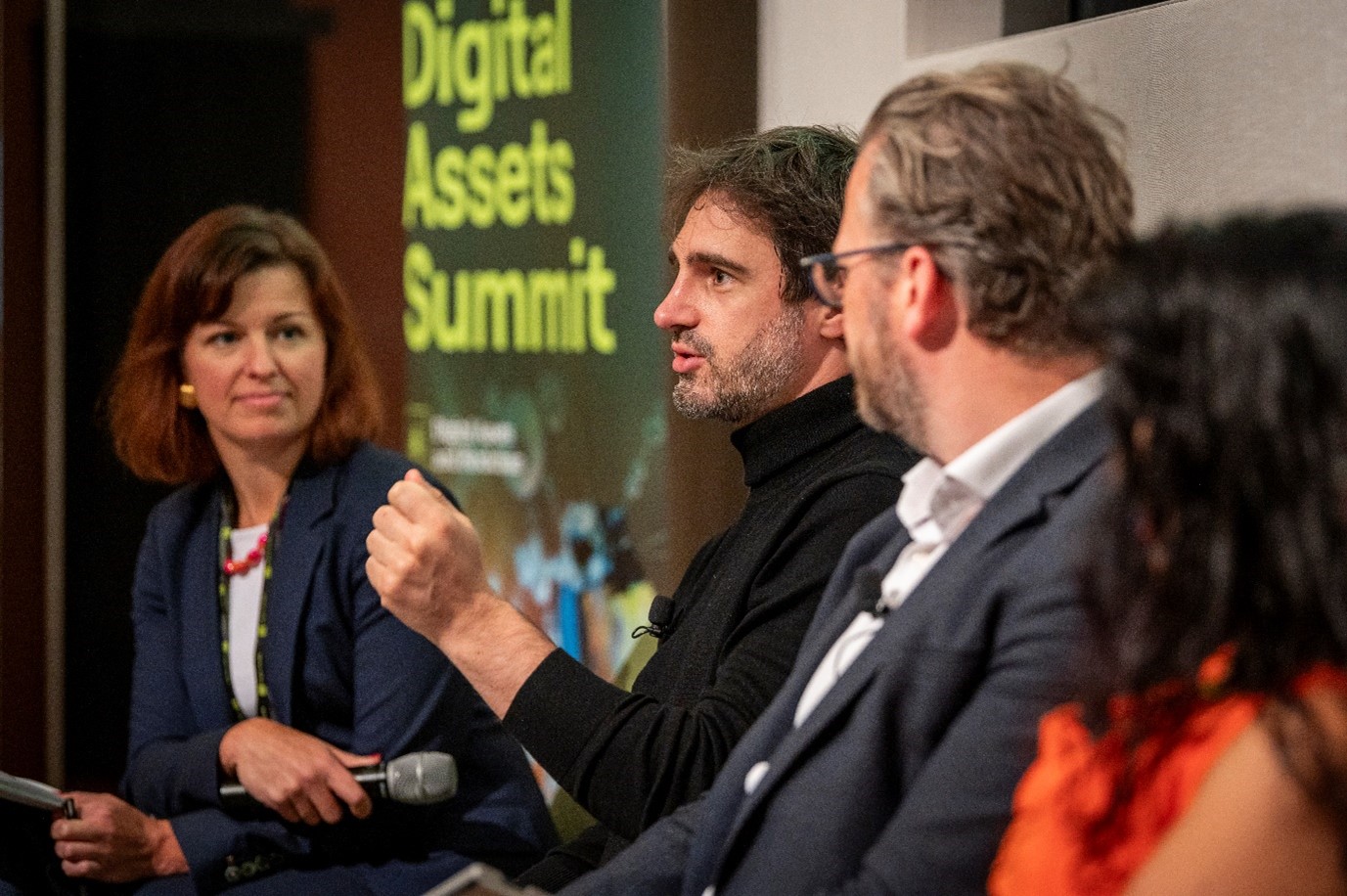
Bryony Widdup, with Max Boonen, PV01, Peter Left, Lloyds, and Sonia Chawla, Schroders
Global Roundup
In the run up to the Summit, we have been hosting roundtable discussions with our clients in our offices across Europe, Asia, and the U.S. on the topic of digital asset adoption in financial institutions. During the Global Roundup, nine Hogan Lovells Partners joined to report back on these discussions, summarising how digital assets are being adopted across the globe – in only three minutes.
First to the task was Hong Kong. Andrew McGinty reported that, generally speaking, jurisdictions such as Hong Kong and Singapore have taken more of a piecemeal approach to regulation, in contrast with the comprehensive framework introduced by the EU. Across the bond market in Hong Kong, there have been a number of notable issuances, including the green digital bond issued by the Hong Kong Government. On the current impediments, McGinty spoke of the need for clarity in surrounding laws, such as on cyber security and insolvency.
Elisabetta Zeppieri was next to the (virtual) stage, dialling in from Milan to report on Italy. Here, the focus of regulatory developments was on the transition from the existing regime applicable to virtual asset service providers, to the new framework under MiCA. Italian legislators are working on transposing MiCA into the legal framework, with a draft Decree on the horizon which will clarify relevant timelines.
Reporting on Frankfurt, Jochen Seitz, commented on how in Germany, since 2021, there has been an expansion of the relevant regime under the Electronic Securities Act; recently, new draft bills were introduced to implement the DORA and MiCA frameworks. In terms of industry trends, Seitz characterised the uptake of tokenisation as stable, but not booming. In the first half of 2024, Germany the number of tokenised issuances have increased, though they were mostly relatively small issuances, bar two of significant size—one from KfW and one from Siemens.
In Luxembourg, Ariane Mehrshahi joined us to report on the continued developments in blockchain-related law, noting that the framework for digital bonds has been introduced since 2021. New proposals have been introduced to amend the legislation, including the introduction of the concept of a “control agent” into legislation. Importantly, the proposals will extend the digital bonds framework to equity instruments such as shares and fund units.
Speaking for Brussels, Philip van Steenwinkel reported that in light of the introduction of MiCA and the DLT pilot framework, and other policy / regulatory developments, industry now needs to get to grips with the latest developments. Key points of uncertainty faced by the market are around the exact scope of application of MiCA. In the discussions with market players, there was a sense that industry recognised its own role to play in further shaping the regulatory environment, and indicating to lawmakers where further certainty was needed.
Vincent Fidelle, speaking for France, noted that there has been a market shift of late from proof of concepts, to pilots and real transactions. In order to reach the tipping point for institutional adoption, there are three key factors to consider: regulation to provide clarity and confidence to the market, robust infrastructure to enable safe scaling of projects, and appropriate use cases to demonstrate the value of adopting such new technologies. On the impediments, the participants of the roundtable spoke of the challenges surrounding the cash leg of digital asset transactions, interoperability, and the need for a central bank digital currency. Some participants also raised the issue of “reversibility” (i.e. the possibility of issuers of tokenized instruments to “reverse” to traditional forms), as well as complexities surrounding DeFi.
Next, we turned to London, where Roger Tym reported on market developments in the UK, noting the advent of new use cases for tokenisation (e.g. the tokenisation of money market funds) and new exchange traded products, as well as the start of digital bond issuances. From a regulatory perspective, stablecoin legislation is being developed, and the UK has also seen the launch of the Digital Securities Sandbox. Legacy infrastructure continues to represent an impediment, including in terms of the cost of transition to new systems. Further, there is work to be done on ensuring that the digital assets regime and payments regimes are not at odds with one another. Growth is on the agenda for the new government, and as a key area of innovation, digital assets and tokenisation will be seen as an area for growth. In the year ahead, we expect to see the next stages of the Bank of England’s Digital Securities Sandbox, development of legislation for staking, the potential for the growth of money market funds tokenisation, and perhaps even a digital gilt and a digital pound.
In Dublin, Eimear O’Brien commented on the fact that digital asset adoption in Ireland was in a nascent state, but there have been some movements towards digital assets adoption, particularly in the funds industry (which rivals Luxembourg’s) – noting that the Irish regulator has expressed guidance on investments in digital asset. Industry would also welcome a recognition of the benefits offered by tokenisation, particularly in the funds space – however the investment that would be required in order to update legacy infrastructures, and the regulatory attitude towards the crypto-asset space, continue to pose challenges.
In Washington D.C., Sara Lenet noted that this has been a year of “building” and working towards institutional adoption in the U.S., but that this means different things to different institutions. For some, digital assets are already considered to be ‘business as usual’. For others, they have not begun their journey to adopting distributed ledger technologies at all. From a policy and regulatory perspective, this year witnessed more nuanced discussions among lawmakers which helpfully distinguish between cryptocurrencies and tokenisation. Given that it is an election year, it is not surprising that no major legislative milestones were achieved, but it is significant that in May, the US House of Representatives passed FIT21.
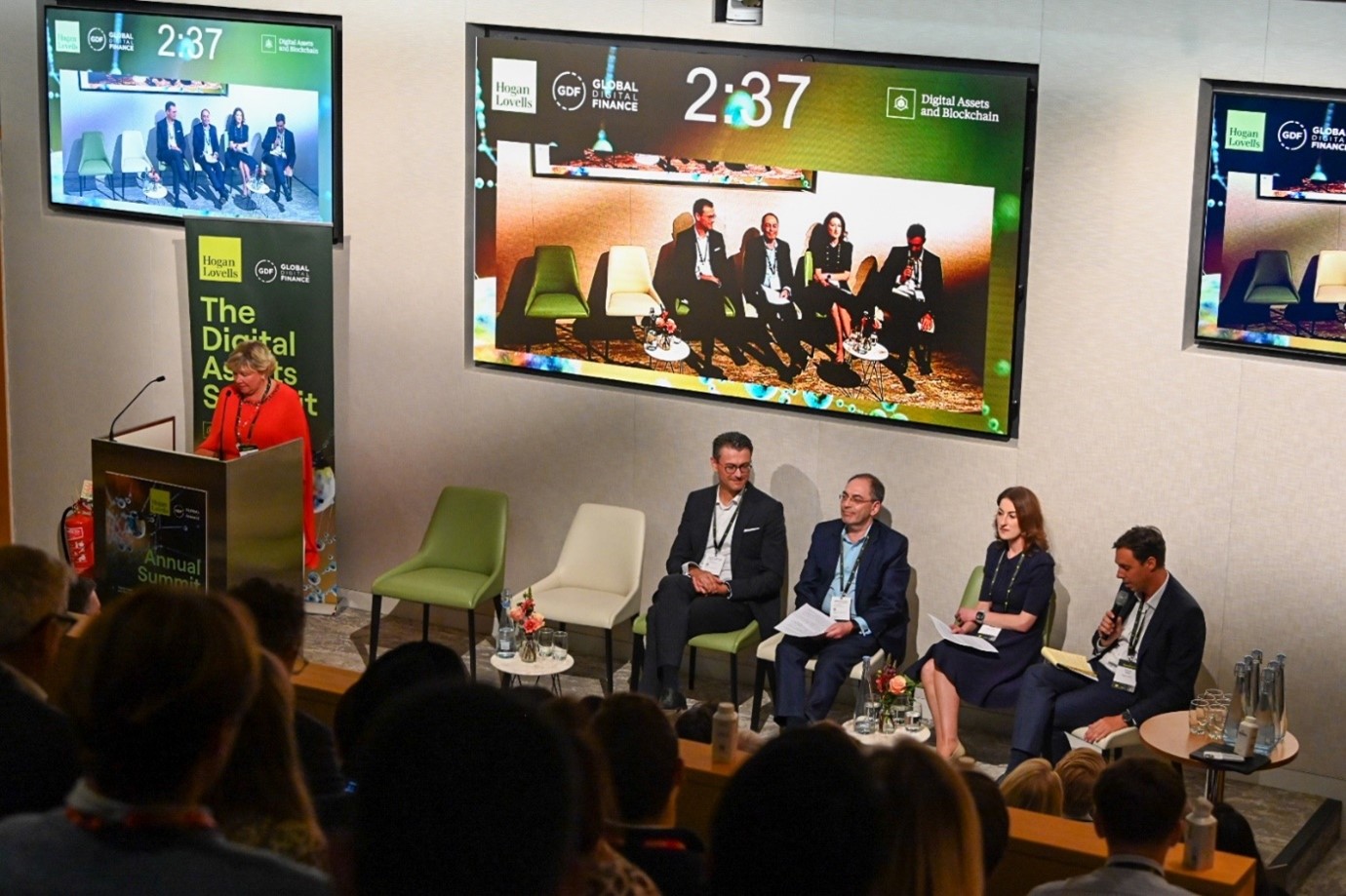
Sharon Lewis, Jochen Seitz, Roger Tym, Eimear O’Brien, and Vincent Fidelle during the Global Roundup
The role of policymakers and regulators in shaping a future digitalized financial system
Panel discussion
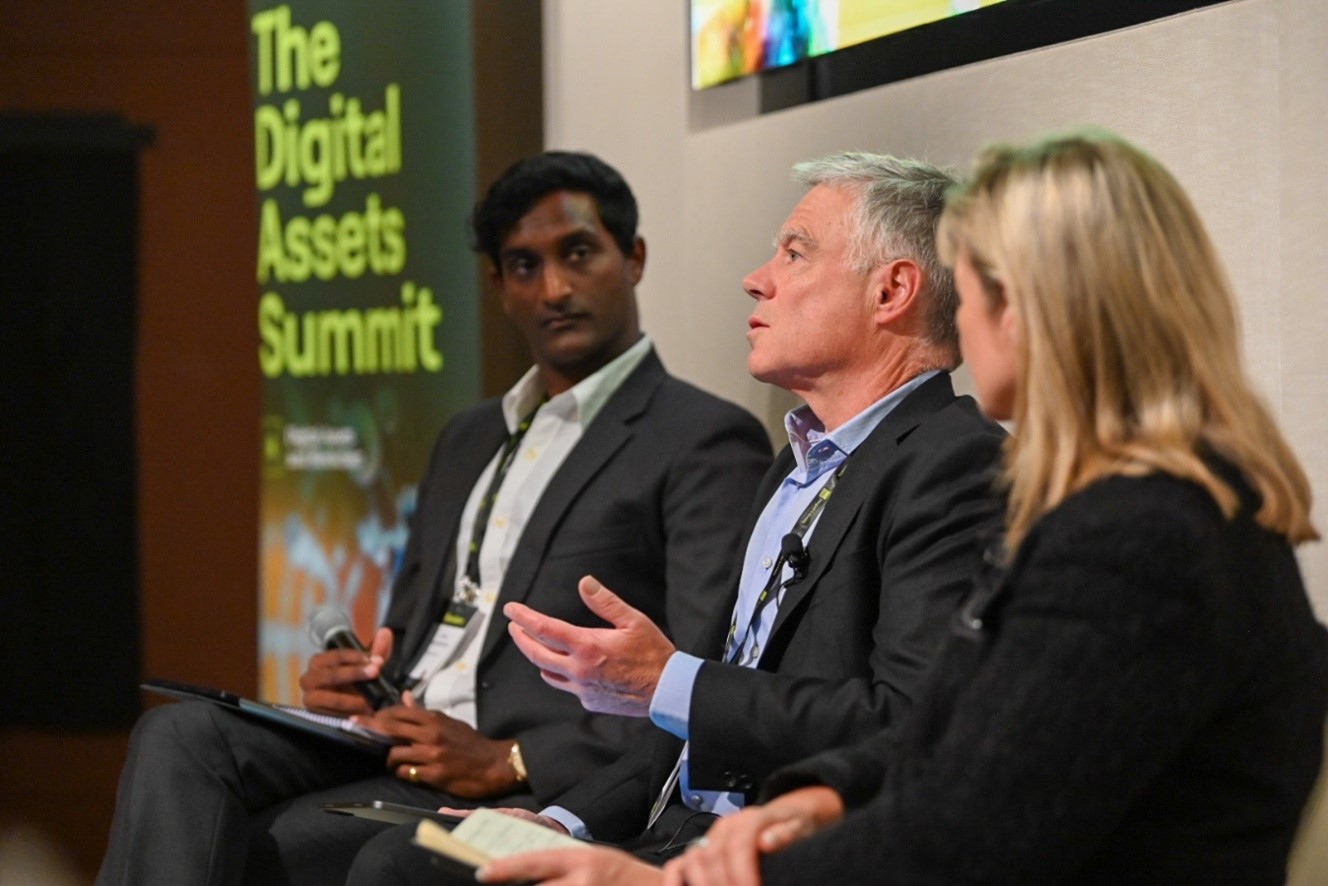
Lavan Thasarathakumar with David Geen, Bank of England, and Baroness Kay Swinburne
The panel on the role of policymakers and regulators was led by Lavan Thasarathakumar, Senior Advisor at Hogan Lovells. On the panel was Christina Rolle, Executive Director at the Securities Commission of the Bahamas; Ivan Keller, Policy Officer at DG FISMA of the European Commission; Baroness Kay Swinburne from the House of Lords; and David Geen, Senior Technical Advisor in the Legal Directorate of the Bank of England.
The panel was generally in agreement that inconsistency in regulatory approaches across jurisdictions and the absence of a global taxonomy in the digital asset space continues to be an issue. However, as Baroness Swinburne noted, analogous issues have yet to be solved in the context of decades-old “traditional” securities laws—it is unclear whether alignment can be achieved in the world of digital assets. Rolle further commented on the challenges posed by divergent approach being taken by the United States, as a major jurisdiction in global capital markets. Keller also addressed the difficulties from an EU perspective, where multiple layers of legislation (i.e. Member State laws vs EU-level laws) give rise to additional challenges in forming a harmonized market, and noted that the European Commission is taking steps to understand the approach to tokenization being taken by individual Member States on a national level.
With reference to the metaphor put forward by Commissioner Peirce describing herself as “more of a beach than a sandbox type of regulator” in her view of the UK’s Digital Securities Sandbox (click here to listen to our podcast conversation with Commissioner Peirce), the panelists offered contrasting views on the appropriate regulatory approach to facilitate innovation. Ultimately, regulators are continuously faced with the challenge of balancing financial stability, market integrity and the need to ensure investor protection, against the need to promote innovation.
Moreover, it is evident that, notwithstanding the usefulness of jurisdictional cooperation and global standards, different approaches must necessarily be taken by policymakers in light of the differing circumstances of each jurisdiction. For example, while the UK and EU have introduced regulatory sandboxes (i.e. the Digital Securities Sandbox and the DLT Pilot Regime, respectively), Rolle explained how the characteristics of the market in The Bahamas is not particularly suited for a sandbox approach, particularly when many entities in The Bahamas seek to service overseas clients.
Another point of distinction is in the issuance of a central bank digital currency (CBDC). While the UK and EU have not formally come to a decision on whether or not to issue a CBDC, the Central Bank of The Bahamas introduced the Sand Dollar (a digital version of the Bahamian dollar) in 2019. Rolle highlighted that the inherent difficulties in accessing banking services due to the archipelagic nature of The Bahamas meant that the Sand Dollar potentially offers much more immediate value to Bahamian residents, relative to a “digital pound” or a “digital euro”.
The Digital Payments Forum: From stablecoins to tokenized deposits
Panel discussion
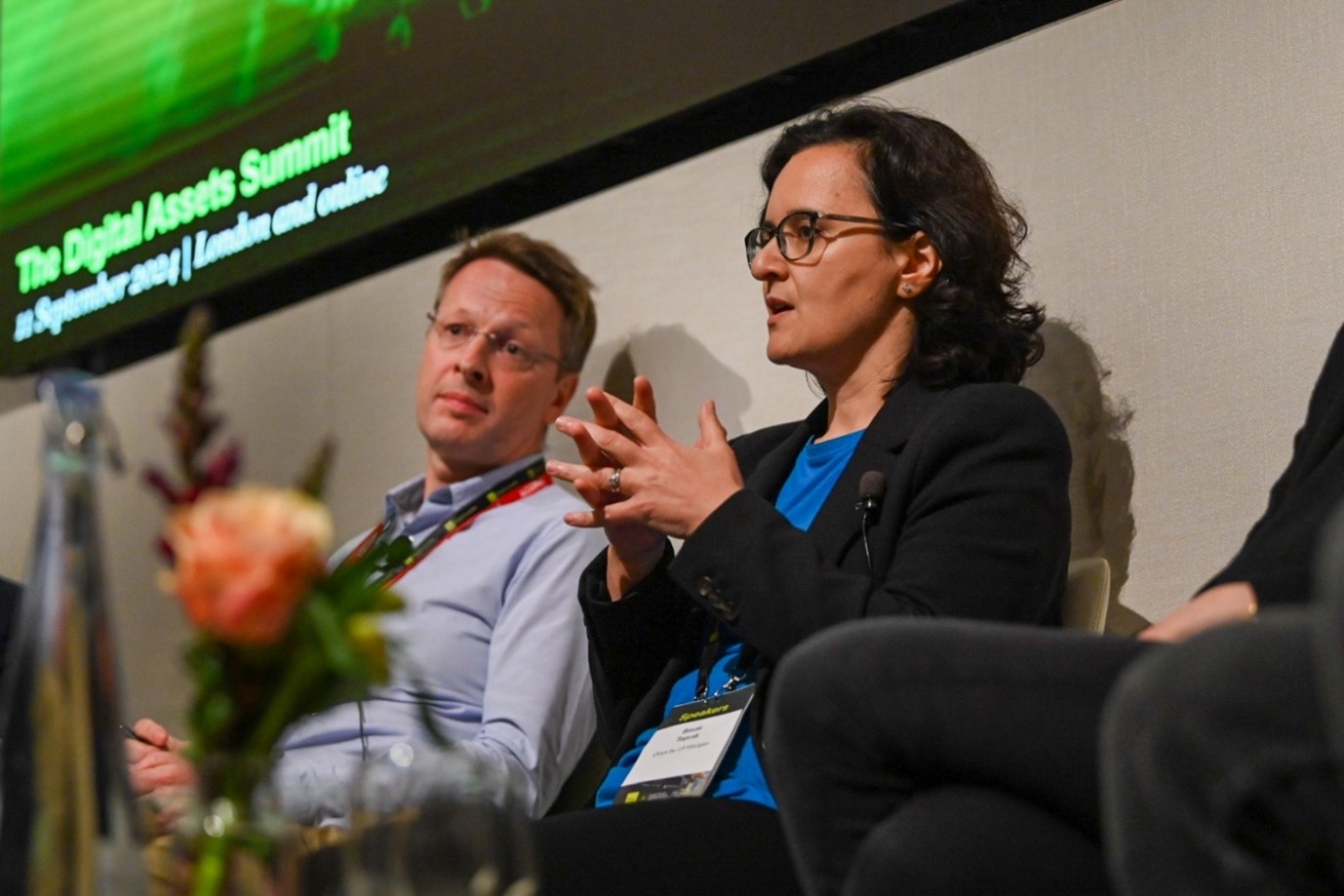
Basak Toprak, Onyx by JPM, and Angus Fletcher, Fnality
John Salmon, Hogan Lovells Partner and Co-head of the Digital Assets and Blockchain practice, moderated the panel discussion on digital payments. The panel discussion also served as the soft launch for the GDF Digital Payments Working Group to be co-chaired by John Salmon and Block. Joining the panel was Angus Fletcher, CEO at Fnality; Claire Wells, Chief Legal Officer at Kiln; Basak Toprak EMEA Head of Coin Systems at Onyx by JPM; and Guillaume Chatain, Head of Sales at SG Forge.
The panelists spoke of the use cases for digital payments from their various perspectives, such as the use of tokenized commercial bank money for cross border payments, the potential of stablecoins in the DeFi space (e.g. as a hedging instrument or as collateral in lending activities) as well as a settlement instrument, and other solutions such as in the case of Fnality, which constitutes a unique, public-private solution (involving an omnibus account at the Bank of England) that is not technically central bank money, but shares much of the same characteristics. It was generally agreed that digital payment solutions which support transactions in tokenized assets are an integral part of the equation.
Fletcher further highlighted the opportunities which may be offered by innovations in the payment leg of transactions from a wholesale perspective, not only in the context of DLT-based workflows, but also in the context of traditional markets. Additionally, Wells remarked that more can be done to innovate in the domestic markets (as well as in terms of cross border transactions), commenting that in the UK, “the most programmable you get is a standing order”.
On policy and regulation, it was noted that on the one hand, the EU’s Markets in Crypto-asset Regulation (MiCA) presents a challenge for stablecoin issuers due to new reserve management and capital adequacy requirements. On the other hand, having a legal framework in place in which stablecoin issuers can obtain regulatory permissions to issue stablecoins can help to enable the growth of the stablecoin activity in the EU.
While much of the panel discussion focused on innovations in private forms of digital money, the panel recognized that a digital form of central bank money to support interbank settlement would be valuable to support growth and interoperability in this space—although, as Toprak noted, there are other solutions such as Partior, which can provide a shared ledger environment.
Fletcher also raised the issue of back-end integration costs and the level of investment required when developing novel solutions, which—coupled with the absence of concrete figures to support a commercial business case and the potential risks—may present internal barriers on an entity-level.
Ultimately, the “right” instrument to use will depend on individual needs and the use case, and the future of digital money and payments is likely to include a mix of instruments, from stablecoins, to tokenized deposits, to central bank digital currencies. Chatain further emphasized that interoperability between the various instruments, and collaboration between financial entities, will be key.
Read our comparative guide on digital money here
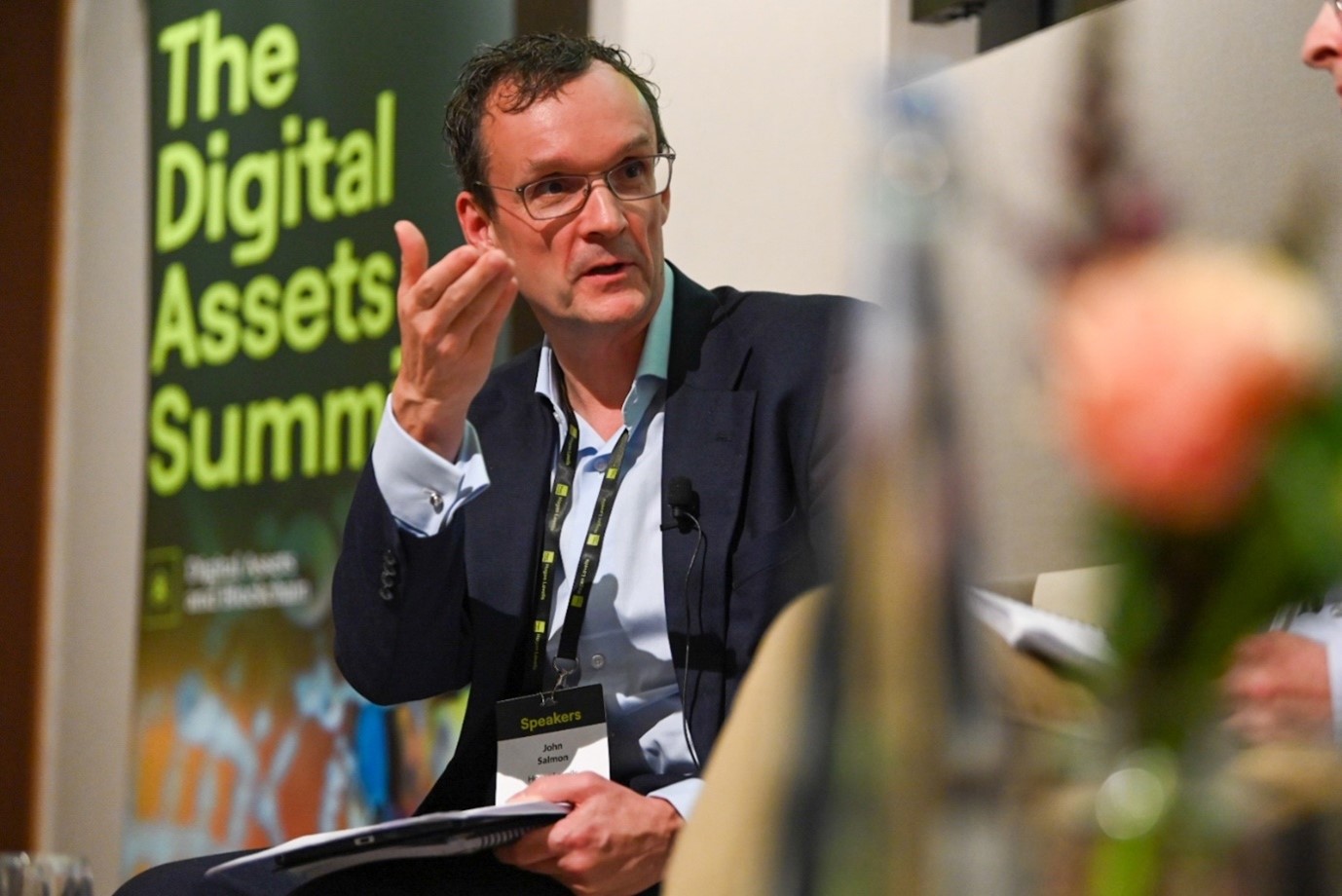
John Salmon moderating the Digital Payments Forum
Digitalized and decentralized: the role of FMIs in tokenized finance
Panel discussion
Hogan Lovells Partner Michael Thomas moderated the panel discussion on the role of financial market infrastructures (FMIs) in tokenized finance. Joining the panel was Martin Watkins, Chief Executive Officer of Montis; Natasha Benson, Chief Operating Officer of Ownera; Stefano Dallavalle, Head of Product of R3; and Richard Fenner, Director of Public Policy at Euroclear UK & International.
The panel discussed the significance of FMIs in supporting digital assets, and opportunities and challenges around their digitalization. Watkins noted the need for infrastructure to be able to connect analog systems with newer technologies on a macro level—importantly, such newer technologies have the potential to allow for better lifecycle management through programmable instruments and ensuring integrity of the transaction, pseudo-atomic settlement, legal certainty at the moment of transfer arising from the transparency offered by distributed ledger technologies (DLT), and easier reconciliation where, for example, a transfer agent and registrar using the same ledger as a single source of truth.
Dallavalle highlighted that interoperability remains one of the biggest challenges for adoption, and noted how R3 aims to facilitate adoption of DLT by removing the concerns around choosing the “wrong” ledger technology. Benson also described the solution offered by the FinP2P Protocol, which provides a routing solution for communication between different systems (whether legacy or DLT-based), thereby facilitating the interaction between FMIs and other market participants.
Fenner noted that, from the perspective of Euroclear, operational resilience remains a key priority, and although how an FMI operates may evolve in line with technological innovations of the time, the fundamental objective of FMIs are unlikely to change.
A key point of focus was the impact of different regulatory frameworks on the activities of FMIs, and their choice of jurisdictions. Watkins noted that, for example, while the laws of Germany may restrict the activities of Montis due to additional licensing / authorisation requirements, the laws of Luxembourg provide a more appropriate framework within which Montis can operate—similarly, Montis intends to be involved in the UK’s Digital Securities Sandbox.
On regulatory sandboxes, a contrast was made between the UK approach which allows the Bank of England the flexibility to adjust relevant value thresholds and the Treasury to issue new statutory instruments, and the EU’s DLT Pilot Regime under which no DLT market infrastructures have yet been authorised, partly due to industry concerns around thresholds and duration of the regime ( among other things). Still, there is value in the harmonization of the EU framework (beyond Luxembourg) as a result of the DLT Pilot Regime—as Fenner noted, there is a risk of fragmentation in regulations and standards across regions, as there is currently no international standard setting body. Importantly, depending on the success of the Digital Securities Sandbox, the UK has the potential to put in place a legislative framework for digital FMIs to operate in, and to deliver the benefits of DLT to the markets.

Michael Thomas, with Martin Watkins, Montis, Stefano Dallavale, R3, Natasha Benson, Ownera, and Richard Fenner, Euroclear
Closing Remarks: Baroness Swinburne, Sharon Lewis and Lawrence Wintermeyer
In closing, Hogan Lovells Partner and Co-head of the Digital Assets and Blockchain Practice Sharon Lewis was joined by Baroness Swinburne and Lawrence Wintermeyer, Executive Co-Chair of Global Digital Finance.
The three reflected on the outcome of the global roundup, in which, as Wintermeyer noted diplomatically, “everyone was a winner!”. Moreover, this past year has demonstrated a continued trend of increasing institutional adoption of DLT. Lewis also commented on how FinTech has transformed the retail financial services in the past decade, and now, FinTech is coming into the wholesale space in a similar way, with the adoption of DLT.
Regarding challenges to institutional adoption, Baroness Swinburne noted the need for global standards or industry codes of practice, and the issues around cross-border regulatory compliance. Wintermeyer further remarked on the challenges faced by innovators amidst a difficult socio-political environment and, correspondingly, a difficult funding environment.
On a more positive note, the collaborative spirit of the FinTech ecosystem holds great promise for DLT adoption – this is demonstrated in the discussions focused on interoperability and interconnectivity within the GDF and Hogan Lovells community. Swinburne further highlighted the exciting opportunity offered by the disintermediation of, and direct retail participation in, the capital markets through new technologies, drawing attention to the pilots taking place in Germany on corporate bond issuances.
The Summit was brought to a close, and our guests then headed to our drinks reception. Join us next year on 25 September 2024 for another Summit on the latest developments in digital finance, distributed ledger technology, and programmable solutions.

Sharon Lewis with Baroness Swinburne, UK House of Lords, and Lawrence Wintermeyer, Global Digital Finance
Next steps
Register your interest for next year’s event here.
Explore more of the DAB Hub tools, including: